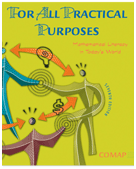
Prof. Ilya Kofman
Email: ikofman
 math.csi.cuny.edu
math.csi.cuny.edu
Website: http://wiener.math.csi.cuny.edu/~ikofman/
 |
Prof. Ilya Kofman |
Office: 1S-209 phone: (718) 982-3615
Email: ikofman  math.csi.cuny.edu math.csi.cuny.edu
Website: http://wiener.math.csi.cuny.edu/~ikofman/ |
| Course Time and Place: |
Mondays: 2:30pm - 4:25pm in 3S-109 Wednesdays: 3:35pm - 4:25pm in 3S-108 Thursdays: 3:35pm - 4:25pm in 2S-219 |
Publisher's website: http://bcs.whfreeman.com/fapp6. We will use some resources on this site, and after each chapter, you will submit a quiz on this site. To log on, you will need to enter the instructor email address (my email above).
Textbook: For All Practical Purposes: Mathematical Literacy in Today's World, Seventh Edition, 2006. ISBN 0716759659. Available at the University Bookstore or online: AddALL. (Alternatively, you can buy the Sixth Edition 2003 online: AddALL.)
Goals: The primary goal of this course is to introduce you to some modern branches of mathematics. By studying unfamiliar examples and patterns, you will get a feel for how mathematical results are discovered. I hope you enjoy exploring beautiful mathematical ideas, but if not don't let on!
Homework: Assignments will be announced in class and then posted on this website. Any changes will be announced in class. Answers to odd-numbered exercises are in the back of the book. I highly recommend working jointly on homework problems with fellow students.
Grading: The course grade will be determined as follows: 20% Quizzes + 45% Exams + 35% Final Exam.
Without exception, you must take the final exam at the time scheduled by the university:
Help: My office hours are after class on Mondays, Wednesdays, and Thursdays 4:30-5:30pm in my office, 1S-209.
Optimal Method of Study: (1.) Come to class. (2.) Read the relevant sections after class. (3.) Do the homework. (4.) Compare your solutions with other students. (5.) Come to office hours or the help room with any remaining questions.
Written work: We write to communicate. Please bear this in mind as you complete assignments and take exams. Work must be neat and legible to receive consideration. You must explain your work in order to obtain full credit; an assertion is not an answer. For specific suggestions see A guide to writing in mathematics classes.
| Topic | Reading from 6th Edition | Reading from 7th Edition |
| Graphs (valence, Euler circuits, Eulerizing graphs) | 1.1 - 1.3 | 1.1 - 1.3 |
| Planar graphs (Euler's formula, order of face, why K_5 is not planar) | notes | notes |
| Identification numbers | 9.1 - 9.3 | 16.1 - 16.3 |
| Binary codes, error-correcting codes | 10.1 - 10.2 | 17.1 - 17.2 |
| RSA public-key cryptography | 10.3 | 17.3 |
| Normal distributions | 7.7 - 7.9 | 5.8 - 5.9 |
| Sampling and confidence intervals | 8.1 - 8.4 | 7.7 - 7.8 |
| Scatterplots, regression lines, correlation | 6.8 - 6.11 | 6.1 - 6.3, 6.5 |
| Tilings | 20.1 - 20.5 | 20.1 - 20.3 |
| Regular polyhedra | p.721, notes | p.758, notes |